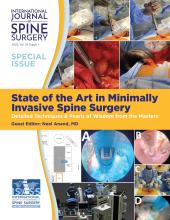Article Figures & Data
Tables
- Table 1
Summary of the findings of studies assessing risk factors for ICU admission and LOS after spine surgery.
Study No. of Patients Procedure Outcome Kay et al, 20166 808 Laminectomy, with or without fusion Blood loss, operative time, heart disease, age, and female gender were determined to be risk factors for ICU admission following spine surgery. Hypertension, body mass index, and diabetes did not reach significance. Harris et al, 20019 109 Anterior or posterior cervical spine surgery Diabetes mellitus (P < 0.002), hypertension (P < 0.02), lung disease (P < 0.03), and heart disease (P < 0.05) were linked to an increased risk of ICU admission. Adogwa et al, 201810 293 Spine decompression and fusion Chronic kidney disease was associated with an increased rate of ICU admission (P = 0.04). Cloney et al, 201911 6869 Spinal fusion Bleeding disorders (P = 0.028), comorbid disease burden (P < 0.001), male gender (P < 0.001), and BMI (P = 0.027) were patient-related variables correlated to ICU admission following spine surgery. Transfusions (P < 0.001), lumbar procedures (P < 0.001), corpectomies (P = 0.007), fracture repairs (P < 0.001), osteotomies (P = 0.006), blood loss (P = 0.009), and operative time greater than 4 h (P < 0.001) were medical and surgical factors predictive of the need for ICU management. Daubs et al, 201612 65 Pediatric substraction osteotomy The occurrence of a major complication increased the length of ICU stay. Raad et al, 201813 425 Adult spinal deformity surgery Preoperative opioid use was a risk factor for increased ICU LOS (P = 0.004). Line et al, 202214 261 Adult spinal deformity surgery Opioid users were more likely to experience longer ICU stays than patients who were not opioid users (P = 0.0065). Nahtomi-Shick et al, 200115 103 Spinal decompression without or with fusion and/or instrumentation and other procedures Age, platelet, and crystalloid administration were predictive of length of ICU stay (P = 0.000). Martini et al, 202116 1124 Posterior cervical discectomy and fusion Primary posterior cervical discectomy and fusion was associated with an increased rate of ICU admission compared with the revision procedure (P = 0.0005). Myers et al, 202117 465 Spinal fracture surgery Neurosurgical management of spine fractures was linked to a greater risk of the need for intensive care compared with orthopedic management (P = 0.04). Hartin et al, 201318 364 Lumbar and thoracic fusion surgery The fusion risk score was an effective indicator of ICU admission, blood loss, and operative time (P < 0.0001). Deogaonkar et al, 201819 242 Lumbar and thoracic fusion surgery The fusion risk score was an effective indicator of ICU admission (P < 0.01), blood loss (P < 0.001), and operative time (P < 0.001). Howe et al, 201120 103 Spinal fusion Estimated blood loss (P < 0.001) and staged procedures (P < 0.001) were correlated with ICU LOS. Gender, operative time, and procedure invasiveness did not correlate with any outcome. Lenga et al, 202221 416 Decompression, with or without fusion Instrumentation increased the risk for a protracted ICU LOS (P < 0.001). Abbreviations: ICU, intensive care unit; LOS, length of stay.
- Table 2
Summary of the findings of studies assessing risk-predicting scores after spine surgery.
Study No. of Patients Procedure Outcome Hartin et al, 201318 364 Thoracic or lumbar and fusion The fusion risk score was a reliable indicator of ICU admission (P < 0.0001), blood loss (P < 0.0001), and operative time (P < 0.0001). Deogaonkar et al, 201819 242 Lumbar and thoracic fusion surgery The fusion risk score was an effective indicator of ICU admission (P < 0.01), blood loss (P < 0.001) and operative time (P < 0.001). Nahtomi-Shick et al, 200115 103 Spinal decompression without or with fusion and/or instrumentation and other procedures The ASA score was correlated with age and predictive of length of stay (P = 0.000) and ICU length of stay (P = 0.012). Howe et al, 201120 103 Spinal fusion The ASA grade was correlated with ICU length of stay (P = 0.011). The ASA grade was also associated with complications (P = 0.030) and discharge to skilled nursing facilities (P = 0.008). The CCI was correlated with complications (P = 0.028) and discharge to skilled nursing facilities (P = 0.039). Kay et al, 20166 808 Laminectomy, with or without fusion The ASA score was a predictive factor of ICU admission (P = 0.008). Ibrahim et al, 202022 101 Multilevel spinal fusion Lower ASA and CCI scores were consistent with greater patient-perceived improvement in health. Khechen et al, 201923 298 Single-level minimally invasive transforaminal lumbar interbody fusion A higher CCI was associated with greater ICU costs (P = 0.002) and higher likelihood of complication (P = 0.005). Abbreviations: ASA, American society of Anesthesiologists; CCI, Charlson Comorbidity Index; ICU, intensive care unit.
Study No. of Patients Procedure Outcome Elsamadicy et al, 201727 643 Multilevel (at least 4 levels) spinal fusion Although patients who benefited from intraoperative monitoring had greater operative times (P < 0.0001), they had a smaller likelihood of being admitted to the ICU (P = 0.015). Menapace et al, 202328 53 Posterior spinal fusion for neuromuscular scoliosis Patients who were operated on by 2 cosurgeons tended to undergo greater corrections (P = 0.089), but in shorter operative (P = 0.0025) and anesthesia times (P = 0.0018) when compared with patients who underwent surgery by a single spine surgeon, with the group, despite only showing a nonsignificant trend toward a lesser rate of ICU admission (P = 0.36). Landi et al, 201729 166 Thoracic and lumbar fracture repair ICU LOS was decreased and neurological function was improved in patients who had early fracture repair (P = 0.001). Abbreviations: ICU, intensive care unit; LOS, length of stay.
- Table 4
Summary of the findings of studies that assessed postoperative and post-ICU admission outcomes.
Study No. of Patients Procedure Outcome Yue et al, 201830 442 C2 fracture repair ICU admission was more predictive of lung infection (P = 0.001) and overall complications (P = 0.005) than floor admission. Cloney et al, 202231 1147 Anterior lumbar fusion The need for intensive care management was significantly correlated with the occurrence of vascular thromboembolic events (P = 0.005). Cho et al, 202032 3933 Degenerative lumbar disease surgery ICU admission was found to be a risk factor for hospital readmission within 1 month of discharge (P < 0.001) when comparing to the subset of patients who did not experience readmission. Lim et al, 200633 - - ICU admission increased the likelihood of infection in patients following traumatic spine injury surgery. Yousef et al, 201834 76 Neuromuscular scoliosis correction surgery ICU length of stay (P = 0.001) and operative time (P = 0.02) were risk factors for postoperative fever. Yearly et al, 202235 112 Spine deformity surgery A stay in the ICU greater than 1 day was a risk factor for the occurrence of a major complication (P < 0.05). Cloney et al, 201911 6869 Spinal fusion Patients who underwent spine surgery and were admitted to the ICU had a rate of venous thromboembolic events of 10.2 % while all spine surgery patients had a rate of thromboembolic events of 2.5%. Harris et al, 20019 109 Anterior or posterior cervical spine surgery Heart disease and lung failure were the leading causes of mortality in the ICU after spine surgery. Abbreviation: ICU, intensive care unit.







